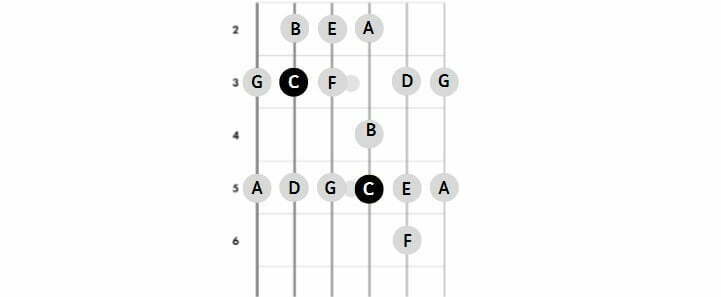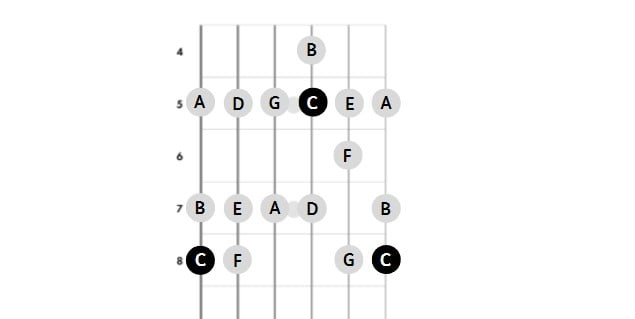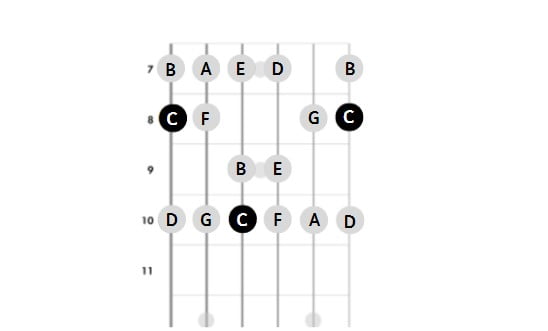The C major scale is an excellent starting point for beginners because it’s frequently used in other instruments, such as the piano. This will allow you to play along with other instruments as you progress in your guitar journey. One of the reasons why the C major scale is ideal for beginners is that it doesn’t have any sharps or flats, which means that you can hear each note in its purest form. In this lesson, we’ll cover the notes in the C major scale and finger positions. Once you’ve mastered the basics, you can use the same notes to add chords and create a harmonized C major scale. To harmonize the C major scale (or any other scale), you can add chords that contain the notes from the scale. The first step in learning a scale is to comprehend which notes to play.
Contents
NOTE ON THE C MAJOR SCALE
- C
- D
- E
- F
- G
- A
- B
In the following section, we’ll discuss the C major scale positions, so you’ll understand which fingers and hand shapes to use to play each note on every string.
C MAJOR SCALE POSITIONS
To play the C major scale, you must have a fundamental knowledge of how to read guitar neck scale diagrams. In the diagram below, the numbered dots show how the scale pattern appears on your guitar’s fretboard. Each number corresponds to a finger, indicating which one to use for each note. Use this key to determine the correct finger placement:
- Index finger
- Middle finger
- Ring ringer
- Pinkie
- Thumb
The open strings are represented by the white dots in the diagram. Similar to all guitar scales, the C major scale is made up of various finger positions. To play the scale, you’ll need to develop finger dexterity to effortlessly place your fingers on the correct frets. Each note in the C major scale (C, D, E, F, G, A, and B) has its own position. This lesson will cover six C major scale positions.
Open position
To play the C major scale in the open position on the guitar, your fingers will remain within the first three frets. For notes on the first fret, use your index finger, for notes on the second fret, use your middle finger, and for notes on the third fret, use your ring finger.

1st position
When playing the C major scale in the 1st position on the guitar, the fourth fret will be added. The diagram below shows the notes that you will play in this position.

4th position
Playing the C major scale in the 4th position on the guitar will require more finger movement, but mastering this position will enable you to improvise and play notes up and down the guitar neck. In this position, you’ll use your index finger for notes on the fifth fret, your middle finger for notes on the sixth fret, your ring finger for notes on the seventh fret, and your pinky for notes on the eighth fret. To play notes on the third string, you’ll need to shift your fingers. Move your index finger to the fourth fret to play the B note, use your middle finger to play the C note on the fifth fret, and play the D note on the seventh fret with your pinky. Then, shift your index finger back to the fifth fret on the first and second strings.

7th position
When playing the C major scale in the 7th position on the guitar, you’ll use the seventh to tenth frets. Even though this may seem like a lot of new frets to incorporate, this position actually requires less shifting around compared to the 4th position.

8th position
To play the C major scale in the 8th position on the guitar, you’ll use the eighth, ninth, tenth, twelfth, and thirteenth frets.
12th position
To play the C major scale in the 12th position on the guitar, you’ll use the first four fingers to play notes on the 12th, 13th, 14th, and 15th frets.
C MAJOR SCALE GUITAR TAB
Playing the C major scale on the guitar involves more than just one string; you can play various combinations using different strings as you move down the neck. In this section, we’ll discuss how to play the C major scale using different guitar tabs.
The low E or 6th string
To play the C Major scale, start on the high “E” string and then play it in reverse to hear it in descending order.
The low A or 5th string
If you want to listen to the C Major scale in a lower range, you can start playing it on the A string in the following manner
The low D or 4th string
To play the C major scale starting on the D string (4th string), you can use the following fingering. The majority of your finger movements will involve shifting positions across the B string, which spans from the 10th to 13th frets.
The low G or 3rd string
You can also play the C major scale by starting on the G string (3rd string), beginning at the 5th fret and focusing your finger movements on the high E string, which spans from the 5th to 8th frets, before descending back to the G string.
C MAJOR SCALE EXERCISES ON GUITAR
To enhance your C major scale learning process, we’ll practice some C major guitar exercises. Before attempting these exercises, ensure that you have practiced the C major chords and guitar positions mentioned earlier. Once you have memorized those chord forms, these exercises will help you keep your fingers agile and navigate the fretboard more easily. These exercises will involve playing the notes in ascending and descending order, starting from the lowest root note to the highest root note, which is the best way to learn the C major scale.
C MAJOR SCALE ASCENDING AND DESCENDING
To play the C major scale in ascending order, begin with the root note C and play the notes in sequence: C – D – E – F – G – A – B – C. Then, go back down the scale by playing the notes in reverse order: B – A – G – F – E – D, until you reach the lower C. You can practice these drills and exercises in various positions, such as open, first, fourth, or others, using the scale tablature provided above. Playing each position forward and backward will help you appreciate the differences in tone and octave. Even though the C major scale will always contain the same notes, some may have a higher or lower pitch than others, depending on the position. Practicing these scales in different positions will help you develop your aural skills and recognize the same note at varying pitches.
C MAJOR SCALE CHORDS
The C major scale has seven guitar chords or triads associated with it, just like the scale itself has seven notes. In this section, we’ll introduce you to the C major scale guitar chords by providing some fundamental music theory. As we introduce each chord, use the diagrams to identify which fingers to use and which strings to play.
- C Major: A major chord consists of three elements: the root note, the major 3rd, and the perfect 5th. In the case of the C major chord, the root note is C, the major 3rd is E, and the perfect 5th is G.
- D Minor: The D minor chord consists of three notes: the root note which is D, the minor third note which is F, and the perfect fifth note which is A.
- E Minor: The E minor chord is another minor chord that belongs to the C major scale. It consists of three notes: the root note which is E, the minor third note which is G, and the perfect fifth note which is B.
- F Major: After discussing minor chords that belong to the C major scale, let’s switch back to major chords. For the F major chord, the three notes are: the root note which is F, the minor third note which is A, and the perfect fifth note which is C.
- G Major: The G major chord is composed of three notes: the root note which is G, the major third note which is B, and the perfect fifth note which is D.
- A Minor: To form the A minor chord, we use three notes: the root note which is A, the minor third note which is C, and the perfect fifth note which is E.
- B Diminished: To play the B dim chord, you need to place your fingers in the positions shown in the diagram. The chord is made up of three notes: the root note which is B, the minor third note which is D, and the perfect fifth note which is F.
